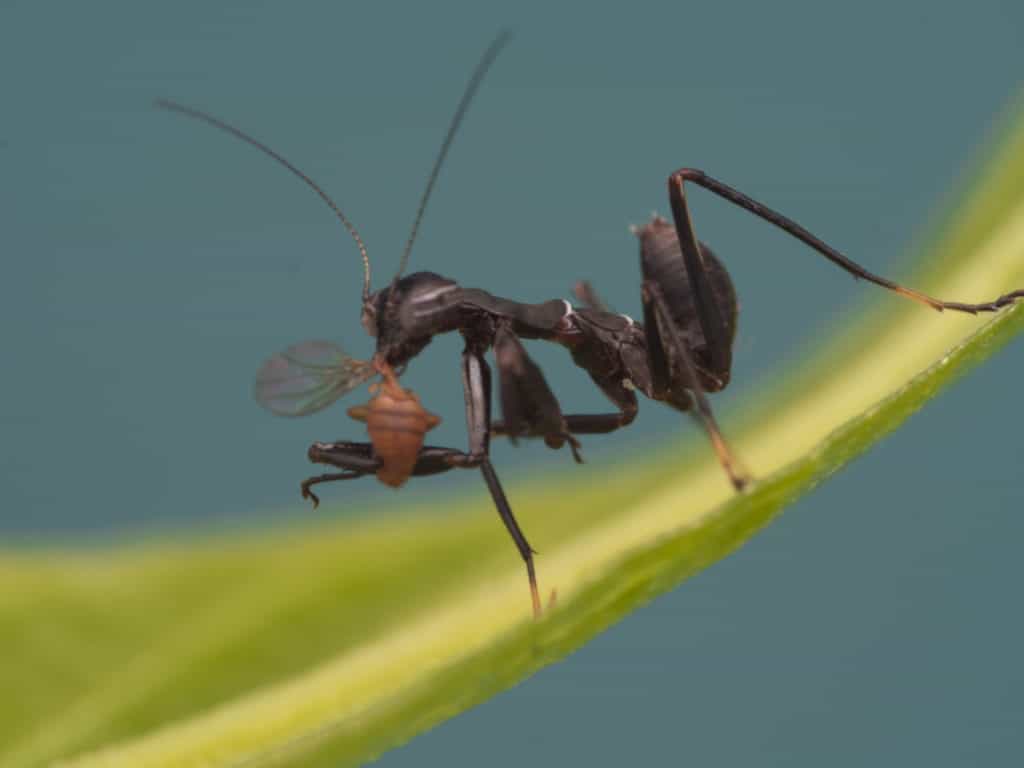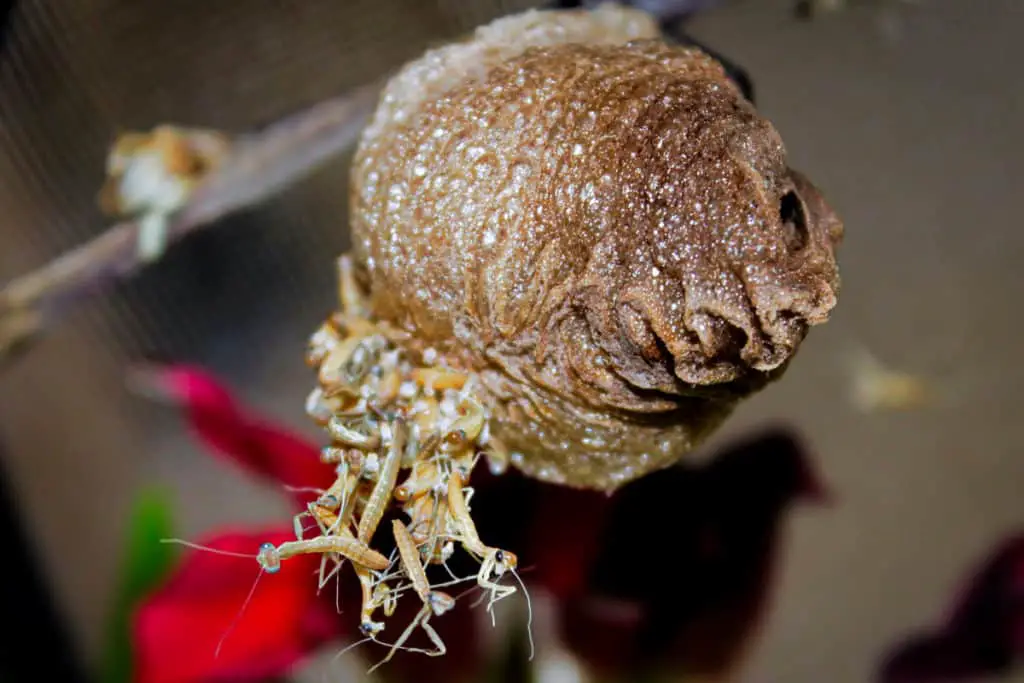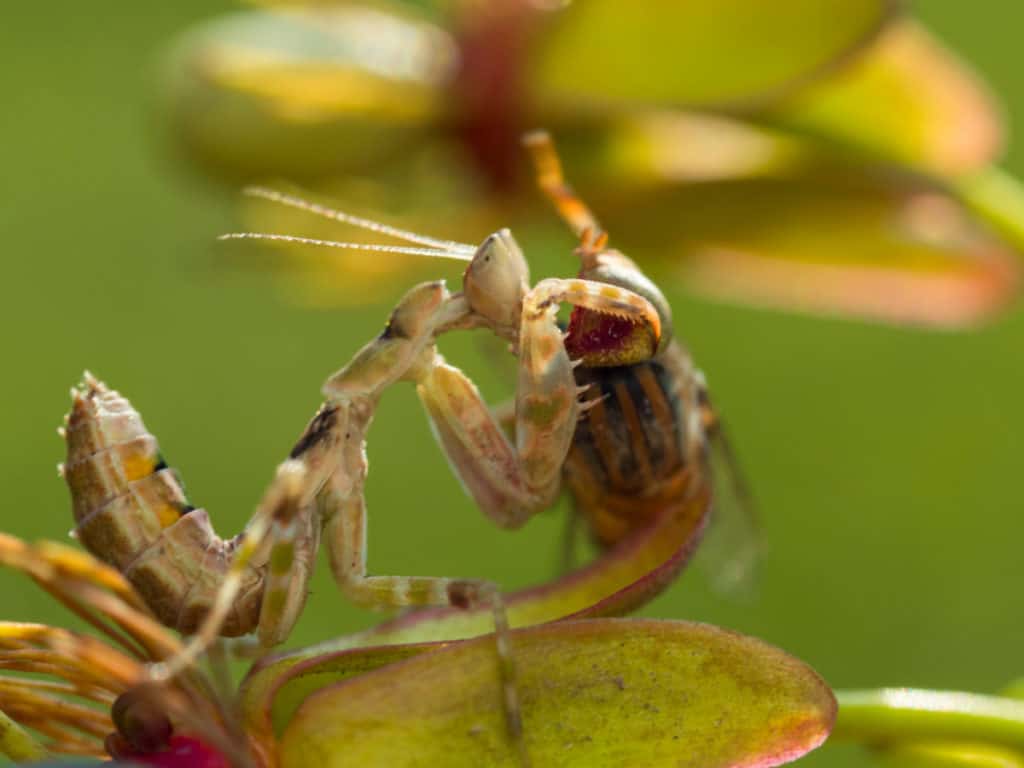Have you ever heard the “horror” stories about the female praying mantis brutally biting the head off of the male shortly after mating and then devouring his corpse for nourishment? Well, while not all praying mantis species cannibalize their mates, this story is far from being a myth or fiction.
Praying mantises are ferocious predators, and even from a young age, they are naturally born killers.
So what do baby praying mantis eat? Baby praying mantis (Nymphs), are born hunters, preying on small insects shortly after hatching. Eating aphids, fruit flies, other small insects even other praying mantis. The baby praying mantis diet is only limited by their size as they grow the size of the prey also increases.
Once they grow to adult size, their prey size can increase significantly and can even include reptiles or small birds.
Whether you have a pet mantis or observe one in the wild, their diet will consist of the same prey, and therefore caring for them is relatively easy.
Read on to find out everything about the baby praying mantis’ diet.
What Do Baby Praying Mantis Eat?
A baby praying mantis will eat pretty much any prey that they can find, granted it is small enough not to overpower the mantis. Aphids are a favorite for nymph mantis because they are very easy to catch, there are usually a lot of them and their soft bodies are easy to consume.

Nymph mantises are aggressive little hunters and if there is not a good supply of small prey they will even resort to cannibalism. Because there are often large numbers hatching at the same time cannibalism is not that uncommon in this early stage of life.

Praying mantis are voracious eaters and bold hunters so the size of their prey will increase as they grow in size. They very effectively take on prey that is almost as big as they are.
How And What Should I Feed My Baby Praying Mantis?
The easiest way to feed your pet praying mantis would be to place live food in the enclosure and then allow the mantis to hunt the prey. Always keep an eye on the process to avoid the prey from escaping.
When it comes to feeding, ensure you feed your mantis the right size food items, comparable to the size of their body length.
Always ensure you buy food from a reputable pet store to ensure there are no diseases or contamination.
Food from the garden is basically a free option, and so it might seem like a logical choice to consider. However, if you choose to do this, there are some things you should take into consideration.
Catching insects in the garden to feed your pet mantis could be a bad idea as the insects could be contaminated with pesticides, or the insects could have fed on pollen that could be toxic to the praying mantis.
The risk is small but could be real, so you have to make the decision on whether to take the chance or not.
Best Food For Baby Praying Mantis
Ideal food for baby mantis includes pinhead crickets and fruit flies, but once the mantis reaches a centimeter in size, fruit flies may become too small.
Your mantis will prefer food that moves a lot, such as flies, as opposed to food that can hide, like cockroaches and worms or caterpillars.
There is a variety of food that will be appropriate to feed your praying mantis.
One option is locusts, as they come in a variety of sizes, ranging from nymph stages to adult.
Crickets are generally widely available at pet shops in many different sizes, so make a great food choice.
If you feed flies to your praying mantis, ensure they stay in the enclosure. You can do this by making use of one of two methods – refrigerating them to slow them down, though this may not be necessary as prey mantis are great hunters.
You can use a plastic device called a pooter to easily transfer the fly into the enclosure for your praying mantis to eat.
As a precautionary measure, keep an eye on the feeding process to ensure the insects do not attack the mantis and chew their legs or wings.
The conclusion is that it is a bad idea to release any pet praying mantis in the wild after it got used to being fed.
It seems like they will depend on humans for food, so once released, they might not hunt on their own, and die from starvation.
One user mentioned that they fed their mantis with minced meat instead of living insects, but this is obviously not an ideal situation over the long term, and live prey is advisable.
How Often Does A Baby Praying Mantis Eat?
Unlike your average pets such as dogs and cats, a praying mantis does not have to eat every day to survive.
Usually, in nature, drought periods would mean less available food, so in theory, a predator should be able to adapt to the circumstances and eat when food is available.
When plenty of food is available, the praying mantis will eat more, and potentially even gorge on available food.
You can therefore feed your praying mantis every few days. If food remains in the enclosure for too long, remove it.
Can Praying Mantis Live Without Food?
It is suggested that a praying mantis can live up to six weeks without food.
You can feed them every few days, but it is also possible to wait four days between feeding. It is probably best that you ensure the mantis eats its prey, as hidden prey may mean the mantis may starve without you knowing that it is not eating.
On a somewhat related topic, we have an article on the life expectancy of praying mantis after they have laid their eggs. If you are interested in checking it out the article is called, Do Praying Mantis Die After Laying Eggs?
Do Baby Praying Mantis Need To Drink Anything?
Some sources suggest that all of a mantis’ water requirements are received from the food they eat, while others claim that hatchlings and baby praying mantis needs moisture and will drink water droplets from plants.
They suggest dampening the substrate, but not adding enough dampness to drown the baby mantis in water droplets.
Once bigger, they suggest spraying the cage or housing area with water droplets every few days, but to avoid spraying the mantis.
You do not need to place a drinking bowl in the enclosure.
How Does A Praying Mantis Diet Change As They Grow Larger?
As the praying mantis grows larger, its diet will shift to larger food items.

While it can only eat small insects as nymphs, it will start focusing on beetles, grasshoppers, and crickets, pretty much anything it can find as it reaches adulthood.
Larger mantids can focus on big prey items such as small lizards, amphibians, and small fish, though they generally do not take on prey that is too big.
You can even feed them moths and caterpillars. They have enormous appetites when they grow up.
For a comprehensive look at the diets of adult praying mantis check out this article we have written, What Does A Praying Mantis Eat?
Will My Praying Mantis Bite Me?
The chances of getting bitten by your baby praying mantis are very slim, but not completely impossible. In theory, their brilliant eyesight will assist them in setting you apart from their prey.
Luckily they won’t cause much damage if they were to bite you as they are not venomous, so just make sure you clean the area properly. Always handle them carefully to avoid getting bitten.
If you are interested we do have a couple of articles that get into not only the bites of praying mantis but also if they have the ability to spit. Sounds gross I know, find out more below:
The Wrap Up
Baby praying mantis have very similar diets to that of the adult mantis. It is more the size of their prey that changes, as opposed to the type of prey they prefer.
When the mantis is small, it will feed on aphids, ants, and other small insects and bugs while as it grows larger it will increase the size of its chosen food.
Looking after a baby praying mantis is therefore straightforward, as long as their food is fed to them alive and is not too big, there should be no problem.
We have a bunch of other articles on the diets of other bugs. If you are interested check out the links below:
Vulture Bees: There Are Meat Eating Bees And They Make Honey
What Do Spiders Eat? (Their Fascinating Diets Revealed)
Sources
https://www.healthline.com/health/praying-mantis-bite#do-they-bite-people
https://www.keepingexoticpets.com/praying-mantis-food-feeding/
https://www.keepingexoticpets.com/rear-hatchling-baby-praying-mantis/
https://explorationsquared.com/baby-praying-mantis-care-guide/
https://usmantis.com/blogs/news/what-do-you-feed-your-mantis-how-often-how-much
https://www.keepinginsects.com/praying-mantis/care/
https://www.amentsoc.org/insects/caresheets/praying-mantids.html
